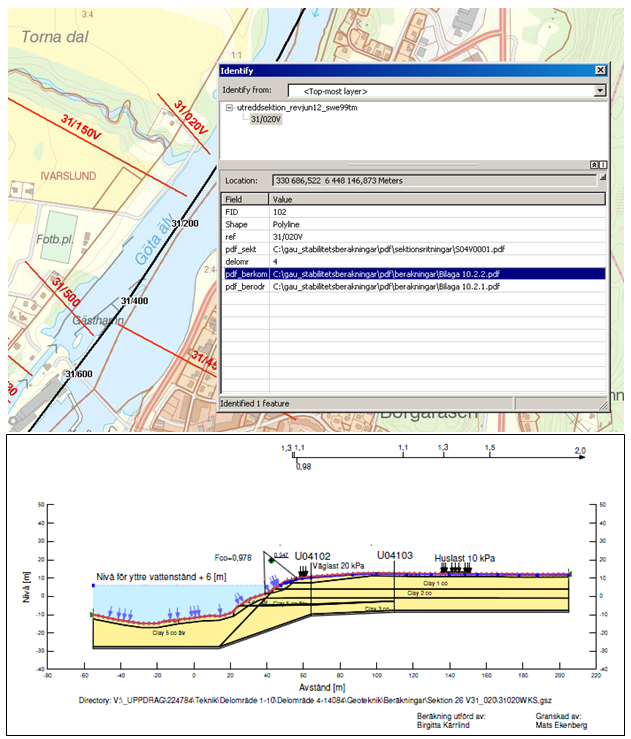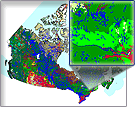geoscientificInformation
Type of resources
Available actions
Keywords
Contact for the resource
Provided by
Years
Formats
Representation types
Update frequencies
status
Service types
Scale
Resolution
-

The compilation represents publicly available reports of geochronological information for Canada. This includes federal, provincial and territorial government publications and reports, university theses, books and journals. Current coverage is limited to those areas that have been the target of recent past compilation efforts, with other areas and updates being included as they become ready. Users should be aware that the compilation may not include all available data for a given area. Every effort is made to report the ages without reinterpreting the original authors' intent. However, care has also been taken to highlight the salient features of the data by which the end-user can make initial judgment on the data robustness. Users are cautioned that because of space limitations and the necessary summarization of often complex datasets, that the original publication should be consulted to verify age interpretations and their rationale. Data may be extracted by the user in tab-delimited text format.
-
Innehåll: Dagens risknivåer, Klimatpåverkan, Utredd sektion (rev juni12, se även Stabilitetsberäkningspaketet), Längdmätning och Bladindelning. Se även https://gis.sgi.se/dokument/geodatasezip/skredriskpaketet_innehåll.xls och "GÄU Slutrapport Del 3 - Kartor", se Samtliga rapporter från GÄU: https://www.sgi.se/sv/samhallsplanering--sakerhet/skredriskutredningar/gota-alv/verktyg-underlag-och-rapporter/ [Geoteknik]
-
Projektet Geomorfologisk kartering i fjällen var en översiktlig inventering och värdering av landformer och områden i fjällregionen. Under perioden 1975-1983 producerades 17 stycken rapporter med tillhörande kartor. Rapporterna beskriver området och dess terrängformer. Det finns även naturvärdesbedömningar och utpekande av geomorfologiskt värdefulla områden. Rapporterna innehåller en hel del bilder och illustrationer. Karteringen är i huvudsak baserad på flygbildstolkning (analog hantering) av infraröda flygbilder i skala 1:60 000. Materialen kompletterades med information från tillgänglig litteratur och fältkontroller. Fältkontrollerna koncenterades till svårklassificerade eller intresseväckande objekt men innefattade även stickprovskontroller. De data som är nedladdningsbara via denna länk är de geomorfologiska kartblad som finns som bilaga till varje rapport. Kartorna är scannade och georektifierade till RT90 2,5gV. För optimalt utnyttjande av materialet bör rapporterna studeras. Rapporterna finns endast i analog form. Rapport och författare: Geomorfologiska kartbladet 27G Sulitelma, Ann-Cathrine Ulfstedt Geomorfologiska kartbladet 28 H SAREK, Olle Melander Geomorfologiska kartbladet 30 J Rensjön, Olle Melander Geomorfologiska kartbladet 19 D Åre, Ingmar Borgström Geomorfologiska kartbladet 21 E Håkafot, Ann-Cathrine Ulfstedt Geomorfologiska kartbladet 18 C Sylarna, Ingmar Borgström Geomorfologiska kartbladet 28 G Virihaure, Olle Melander Geomorfologiska kartbladet 18 D Storsjö, Ingmar Borgström Geomorfologiska kartbladet 29 J Kiruna, Olle Melander Geomorfologiska kartbladet 25 G Ammarnäs, Ann-Cathrine Geomorfologiska kartbladet 17C Funäsdalen, Ingmar Borgström, Leif Geomorfologiska kartbladet 27 H Kvikkjokk, Ann-Cathrine Ulfstedt Geomorfologiska kartbladet 19 C Storlien, Ingmar Borgström Geomorfologiska kartbladet 29 I Kebnekaise, Olle Melander Geomorfologiska kartbladet 28 I Stora Sjöfallet, Gunnar Hoppe, Olle Melander Geomorfologiska kartbladet 20 C Skalstugan 20 D Kolåsen 21 D, Ingmar Borgström Geomorfologiska kartbladet 30 H Riksgränsen (öst), 30 I Abisko, 31 H Reurivare och 31 I Vadvetjåkka, Olle Melander
-

Utredd sektion (reviderad juni 12) med länkar till utförda stabilitetsberäkningar och CAD sektionsritningar. (262 sektioner). Se vidare https://gis.sgi.se/dokument/geodatasezip/stabilitetsberakningspaketet_innehåll.xls och respektive Tekniskt PM och MUR Markundersökningsrapport. [Geoteknik]
-
Borrhål utförda tidigare än 2009 och "utanför" GÄU och som nyttjas till viss del inom GÄU. Över 25.000 sonderingar. Data kommer från Trafikverket Bana Väg i Väst, kommuner m fl. Se https://gis.sgi.se/dokument/geodatasezip/borrhaltidigarepaketet_innehåll.xls och Samtliga rapporter från GÄU: https://www.sgi.se/sv/samhallsplanering--sakerhet/skredriskutredningar/gota-alv/verktyg-underlag-och-rapporter/
-

High resolution forest change for Canada (Change Year) 1985-2011 The forest change data included in this product is national in scope (entire forested ecosystem) and represents the first wall-to-wall characterization of wildfire and harvest in Canada at a spatial resolution commensurate with human impacts. The information outcomes represent 27 years of stand replacing change in Canada’s forests, derived from a single, consistent spatially-explicit data source, derived in a fully automated manner. This demonstrated capacity to characterize forests at a resolution that captures human impacts is key to establishing a baseline for detailed monitoring of forested ecosystems from management and science perspectives. Time series of Landsat data were used to characterize national trends in stand replacing forest disturbances caused by wildfire and harvest for the period 1985–2011 for Canada's 650 million hectare forested ecosystems (https://authors.elsevier.com/sd/article/S0034425717301360 ). Landsat data has a 30m spatial resolution, so the change information is highly detailed and is commensurate with that of human impacts. These data represent annual stand replacing forest changes. The stand replacing disturbances types labeled are wildfire and harvest, with lower confidence wildfire and harvest, also shared. The distinction and sharing of lower class membership likelihoods is to indicate to users that some change events were more difficult to allocate to a change type, but are generally found to be in the correct category. For an overview on the data, image processing, and time series change detection methods applied, as well as information on independent accuracy assessment of the data, see Hermosilla et al. (2016; http://www.tandfonline.com/doi/full/10.1080/17538947.2016.1187673). The data available is, 1. a binary change/no-change; 2. Change year; and, 3. Change type. When using this data, please cite as: White, J.C., M.A. Wulder, T. Hermosilla, N.C. Coops, and G. Hobart. (2017). A nationwide annual characterization of 25 years of forest disturbance and recovery for Canada using Landsat time series. Remote Sensing of Environment. 192: 303-321. DOI: 10.1016/j.rse.2017.03.035. https://authors.elsevier.com/sd/article/S0034425717301360 Geographic extent: Canada's forested ecosystems (~ 650 Mha) Time period: 1985–2011
-

The wetland year count data included in this product is national in scope (entire forested ecosystem) and represents a wall to wall wetland characterization for 1984-2016 (Wulder et al. 2018). This product was generated using both annual gap free composite reflectance images and annual forest change maps following the Virtual Land Cover Engine (VLCE) process (see Hermosilla et al. 2018), over the 650 million ha forested ecosystems of Canada. Elements of the VLCE classification approach are inclusion of disturbance information in the processes as well as ensuring class transitions over time are logical. Further, a Hidden Markov Model is implemented to assess individual year class likelihoods to reduce variability and possible noise in year-on-year class assignments (for instances when class likelihoods are similar). The values can range from 0 to 33 denoting the number of years between 1984 and 2016 that a pixel was classified as wetland or wetland-treed in the VLCE data cube. For an overview on the data, image processing, and time series change detection methods applied, as well as information on independent accuracy assessment of the data, see Hermosilla et al. (2016; http://www.tandfonline.com/doi/full/10.1080/17538947.2016.1187673). A detailed description of the VLCE process and the subsequently generated land cover product, including an accuracy assessment, please see Hermosilla et al. (2018). The focused wetland analyses can be found described in Wulder et al (2018). Geographic extent: Canada's forested ecosystems (~ 650 Mha) Time period: 1985–2011
-

The Manitoba Detailed Soil Survey dataset series at a scale of 1:100 000 consists of geo-referenced soil polygons with linkages to attribute data found in the associated Component File (CMP), Soil Names File (SNF) and Soil Layer File (SLF). Together, these datasets describe the spatial distribution of soils and associated landscapes for nearly all agricultural areas in southern Manitoba, as well as some parts of northern and eastern Manitoba.
-

Forest Elevation(Ht) Stddev 2015 Standard deviation of height of lidar first returns (m). Represents the variability in canopy heights. Products relating the structure of Canada's forested ecosystems have been generated and made openly accessible. The shared products are based upon peer-reviewed science and relate aspects of forest structure including: (i) metrics calculated directly from the lidar point cloud with heights normalized to heights above the ground surface (e.g., canopy cover, height), and (ii) modelled inventory attributes, derived using an area-based approach generated by using co-located ground plot and ALS data (e.g., volume, biomass). Forest structure estimates were generated by combining information from lidar plots (Wulder et al. 2012) with Landsat pixel-based composites (White et al. 2014; Hermosilla et al. 2016) using a nearest neighbour imputation approach with a Random Forests-based distance metric. These products were generated for strategic-level forest monitoring information needs and are not intended to support operational-level forest management. All products have a spatial resolution of 30 m. For a detailed description of the data, methods applied, and accuracy assessment results see Matasci et al. (2018). When using this data, please cite as follows: Matasci, G., Hermosilla, T., Wulder, M.A., White, J.C., Coops, N.C., Hobart, G.W., Bolton, D.K., Tompalski, P., Bater, C.W., 2018b. Three decades of forest structural dynamics over Canada's forested ecosystems using Landsat time-series and lidar plots. Remote Sensing of Environment 216, 697-714. Matasci et al. 2018) Geographic extent: Canada's forested ecosystems (~ 650 Mha) Time period: 1985–2011
-

Forest Basal Area 2015 Cross-sectional area of tree stems at breast height. The sum of the cross-sectional area (i.e. basal area) of each tree in square metres in a plot, divided by the area of the plot (ha) (units = m2ha). Products relating the structure of Canada's forested ecosystems have been generated and made openly accessible. The shared products are based upon peer-reviewed science and relate aspects of forest structure including: (i) metrics calculated directly from the lidar point cloud with heights normalized to heights above the ground surface (e.g., canopy cover, height), and (ii) modelled inventory attributes, derived using an area-based approach generated by using co-located ground plot and ALS data (e.g., volume, biomass). Forest structure estimates were generated by combining information from lidar plots (Wulder et al. 2012) with Landsat pixel-based composites (White et al. 2014; Hermosilla et al. 2016) using a nearest neighbour imputation approach with a Random Forests-based distance metric. These products were generated for strategic-level forest monitoring information needs and are not intended to support operational-level forest management. All products have a spatial resolution of 30 m. For a detailed description of the data, methods applied, and accuracy assessment results see Matasci et al. (2018). When using this data, please cite as follows: Matasci, G., Hermosilla, T., Wulder, M.A., White, J.C., Coops, N.C., Hobart, G.W., Bolton, D.K., Tompalski, P., Bater, C.W., 2018b. Three decades of forest structural dynamics over Canada's forested ecosystems using Landsat time-series and lidar plots. Remote Sensing of Environment 216, 697-714. Matasci et al. 2018) Geographic extent: Canada's forested ecosystems (~ 650 Mha) Time period: 1985–2011
 Arctic SDI catalogue
Arctic SDI catalogue